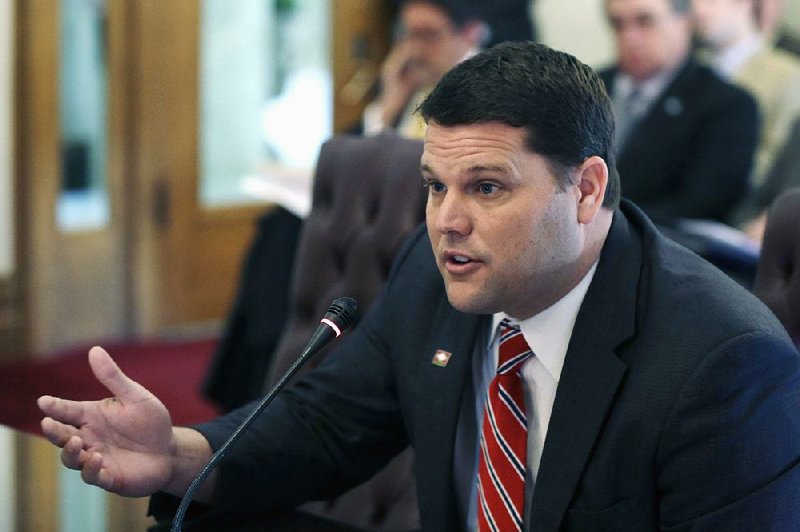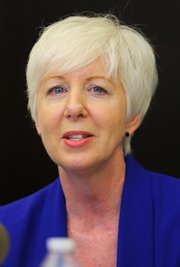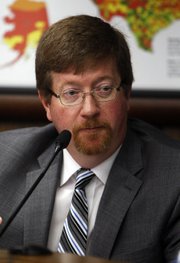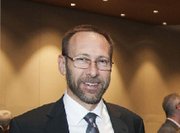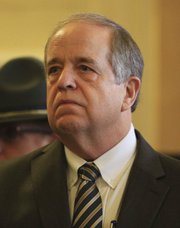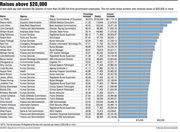The biggest beneficiaries of the overhaul of the state government pay plan work in a wide range of categories: some agency administrators, registered nurses, information-technology employees and various entry-level workers.
The revamped pay plan covers more than 25,000 full-time state workers and became effective in the fiscal year that started July 1.
It doesn't cover Arkansas Game and Fish Commission and Department of Transportation employees. Nor does it apply to the seven constitutional officers and legislative and judicial branches, said Scott Hardin, a spokesman for the state Department of Finance and Administration.
"This plan will not only provide a salary increase of at least 1 percent to all state employees [covered by the pay plan], but it will most importantly boost the state's competitiveness with salaries in the private sector," Gov. Asa Hutchinson said in a recent written statement to the Arkansas Democrat-Gazette.
[DATABASE: Search database of state salaries, raises]
"This will no doubt help with the retention of good employees and the state's ability to reward quality performance," he said.
"Efficiency in state government has always been a focus of mine, and having the ability to keep knowledgeable, reliable and creative employees in state government will go a long way toward making government leaner and more efficient for all Arkansans," Hutchinson said.
The new pay plan also doesn't cover employees at the state's two- and four-year colleges, although it does include employees at Crowley's Ridge Technical Institute, Riverside Vocational Tech School and Northwest Technical Institute, Hardin said.
The plan is on track to cost about $57 million to $60 million on total salaries in this fiscal year, he said.
The plan boosted the average annual salary for the employees it covers from $38,461 as of June 15 to $40,772 in the new fiscal year, Hardin said.
The average salary for about 27,000 employees in the computerized accounting system, which also includes the Game and Fish Commission, some constitutional office and legislative and judicial branch employees, increased from $39,684 to $42,071, he said.
According to the finance department, 12,769 of the employees in the pay plan received more than a 2 percent raise, while 797 employees received a 1 percent to 2 percent raise, and 11,672 received a 1 percent raise.
Another 51 employees got no pay raise -- about half because they are new to the state payroll and the other half because they are employees at Crowley's Ridge Technical Institute as a result of legislation that blocked their raises, said Hardin.
The pay raises became effective July 2 and showed up in checks on July 21. The finance department provided information about each employee's raise on Aug. 1 in response to the Democrat-Gazette's public-records request.
The pay overhaul is the first since 2009. The state personnel administrator, Kay Barnhill, has said the labor market has change dramatically since then.
During four of the previous seven fiscal years, employees received no cost-of-living raise, according to state records. They received a 1 percent cost-of-living raise in 2016 and 2 percent cost-of-living raises in fiscal 2011 and 2014.
The legislation authorizing the new pay plan -- Act 365 of 2017, sponsored by Sen. Bart Hester, R-Cave Springs -- sailed through the Republican-controlled Legislature without a dissenting vote.
The Senate voted 34-0 to approve the measure, and the House voted 93-0 to send it to Hutchinson for his signature.
The governor told the Arkansas State Employees Association's annual convention on Friday that "we are going to take some heat" for the new pay plan, referring to the Democrat-Gazette article.
"You've got some people that are saying 'well there is some that got too much [and] there are others that got too little.' It's not perfect, but it's a huge step forward. We can adjust it as time goes on, but it is an investment in our most precious resource and that is you," Hutchinson said.
'A GREAT START'
The pay overhaul is being financed primarily through budget savings, Hardin said. Additional funds are available in the merit adjustment fund for agencies that may need extra assistance to cover the cost of implementing the new plan.
The payroll for most state agencies that don't include the colleges and universities totaled $1.2 billion in fiscal 2016 and is projected to be $1.2 billion in fiscal 2018, based on the first two pay periods under the new plan. The amount didn't change because of "agency mergers, not filling positions that became vacant, etc.," during this period, Hardin said.
Hardin said the department didn't have information about the total state payroll in fiscal 2017 or 2018.
Earlier this year, another department spokesman said that the payroll totaled $3.039 billion in fiscal 2016 with 59,929 full-time employees, including colleges and universities at the end of fiscal 2016.
Hester said in an interview that "the reality was when we looked at this [pay plan], we didn't have the money to give everybody the raise they deserved. The purpose was to recruit and retain talented people, and we decided to start with the recruiting side.
"We hope we can come in two years [in the 2019 session] and help the tenured people as well," he said. "We wanted something that we can build on, and I think that's something we have done."
John Bridges, assistant director of the Arkansas State Employees Association, called the new plan "a great start."
"They targeted a lot of high turnover positions, such as [information technology] and nurses and program eligibility specialists," he said in an interview.
Bridges said he hopes the Legislature and Hutchinson will next bolster the salaries of employees who received only a 1 percent raise to take care of "salary compression," under which some long-term employees "are just barely above the new people now."
Asked by a state employee what he is going to do to boost veteran employees' salaries in the future, Hutchinson told the association's convention that "that will continue to be a little bit of a sore point.
"Obviously the goal of the pay plan was to be able to recruit and retain. It is not perfect for some longtime employees. Everybody got something in there. But I understand that concern and I am sympathetic to it," he said.
State employees also will be eligible for merit raises instead of one-time merit bonuses this fiscal year based on a new performance review process, Hardin said. The specific percentages for the merit raises will be determined by the governor and the state Office of Personnel Management.
"Many [states], like Arkansas, haven't addressed [their pay plans] in some time due to budgetary constraints, but are having to now because the pay has not been competitive with other employers, limiting states' abilities to recruit and retain employees," said Leslie Scott, director of the National Association of State Personnel Executives.
"Some have been able to provide adjustments, some haven't. Some have implemented across-the-board adjustments, others have targeted hard-to-fill and hard-to-retain positions," she said. "In general, state compensation lags the market and over the course of the past few years the difference between state government compensation and the private sector has widened."
PAY PLAN DETAILS
The overhaul creates four compensation "tables" to replace the previous two tables.
There is now a general salary table for employees in more than 23,600 positions, a medical professional salary table for nearly 900 positions, an information-technology salary table for more than 700 positions and a senior executive salary table for nearly 150 positions.
Employees on the general table received an average increase of $2,133 to $38,486 this fiscal year, while employees on the information-technology table received an average increase of $4,848 to $57,876 this fiscal year, according to information provided by Hardin.
Employees on the medical professionals table received an average increase of $8,542 to $74,542, while the employees on the senior executive table received an average increase of $7,296 to $124,789, Hardin said.
State officials told lawmakers earlier this year that the pay overhaul would bolster entry-level salaries for positions such as registered nurses, state troopers, family-services workers, program-eligibility specialists, correctional officers and residential care assistants -- jobs in which the state has experienced more than double-digit turnover.
Under the new plan, 437 registered nurses received average pay raises of $10,257, or 21.66 percent, to at least the new minimum salary of $63,830, said Hardin.
More than 70 registered nurses received raises of at least $20,000 to boost their salaries to at least $63,830, according to state records.
Other pay raises to new minimum salaries included, according to Hardin:
• 164 state troopers received an average raise of $3,881, or 10.7 percent, to at least the new minimum of $40,340.
• 959 program-eligibility specialists received an average increase of $6,370, or 22 percent, to at least $36,155.
• 493 family-services workers received an average increase of $4,505, or 14.5 percent, to at least $36,155.
• 281 residential care assistants received an average increase of $821, or 4 percent, to at least $22,000.
• 791 employees in Correctional Officer 1 positions received an average raise of $998, or 3.7 percent, to at least $29,046.
The highest-paid state employees, who don't work at higher-education institutions, are Department of Human Services Director Cindy Gillespie, state Education Commissioner Johnny Key and Health Department Director Nate Smith.
Gillespie, Key and Smith each received a 1 percent raise to increase Gillespie's salary from $280,000 to $282,800; Key's salary from $233,488 to $235,823; and Smith's salary rose from $219,779 to $221,977.
The largest raises in dollars, other than colleges and universities, include those largely tied to changing positions, according to the finance department.
Ivy Pfeffer was promoted from assistant commissioner for educator effectiveness and licensure at the Department of Education to deputy education commissioner.
As a result, she received a $41,713 raise to $156,549, which included a 1 percent increase in keeping with the new pay plan, said Hardin.
Sharon Keith, a medical consultant at the Disability Determination for Social Security Administration office, changed from a part-time to a full-time employee and received a $37,679 raise to $110,843, which also included a 1 percent hike through the new pay plan.
John Ahlen, formerly the chief legal counsel at the state Bank Department, received a $34,471 raise to $120,543 partly resulting from his move to a new position as deputy bank commissioner and partly to comport with the new pay plan, Hardin said.
Other large-dollar increases went to John "Smokey" Campbell of Hot Springs, director of the state racing commission and a former member of the now-defunct Arkansas Lottery Commission, who got a $31,635 raise to $96,960. The racing commission is part of the finance department.
"The racing commissioner has always been responsible for both Oaklawn and Southland," said Hardin, referring to the state's two racetracks.
"However, his job duties had never been formally revised to include the added responsibilities of electronic gaming (the 'casino' areas), even though this was very much a part of his position. This new play plan was a good time to get these additional duties formally added to his job description, justifying the raise (for extra duties)," Hardin explained in an email.
Col. Bill Bryant, director of the state police, received a $31,075 raise to $149,862. Bryant manages a 938-person department, and the new plan considered his overall responsibilities, along with the impact of his operation, Hardin said.
"This raise places Col. Bryant in line with the salaries of his colleagues throughout the U.S.," he said.
State police Deputy Director Lt. Col. Tim K'Nuckles received an $18,414 raise to $120,543, and Hardin cited the same reasons for K'Nuckles pay increase.
The salary of Greg Patterson, registered nurse supervisor at the Human Services Department, rose $28,934 to $71,403,
"Nurses were one of the key categories in which the pay plan was focused in order to recruit and retain these health care professionals," Hardin said. "As a nurse supervisor, Mr. Patterson was underpaid compared to his colleagues. The raise gets him to a level more in line with his responsibilities."
A promotion and the new plan bumped the salary of Robert Kacir, a geographic information systems analyst at the Department of Parks and Tourism, by $28,504 to $57,755.
The pay plan was solely responsible for a $26,179 increase for Noel Vint, information-technology division director at the Department of Emergency Management, to $71,704, Hardin said.
Other state department heads and key administrators receiving raises of about $15,000 or more included Alcoholic Beverage Control Enforcement Director Boyce Hamlet, who received a $23,834 raise to $96,960.
In his job, Hamlet now has the added responsibility of the medical-marijuana sector, and "this new, significant responsibility was included in his job description prior to the new pay plan," Hardin said.
Agriculture Department Secretary Wes Ward's pay rose $18,573 to $120,543, "strictly from the new pay plan (no promotion, etc.)," Hardin wrote in an email. "He went from an unclassified grade at $101,969 under the old plan to an SE02 [graded position] making $120,542 (entry of grade)."
Crime Laboratory Director Kermit Channel received a $15,820 raise to $120,543, "considered current market data for this position, along with salary of his colleagues throughout the U.S.," Hardin said.
Securities Commissioner Edmond Waters' $14,557 raise to $120,543 came about from the pay plan, which considered the job's regulatory responsibility along with current market data, Hardin said.
State Budget Administrator Duncan Baird's pay rose $19,465 to $120,543. Baird, a Republican from Lowell, is a former chairman of the Legislature's Joint Budget Committee who ran unsuccessfully for his party's nomination for state treasurer in 2014.
The budget office is in the finance department; the department's positions have statewide responsibility for all agencies and serve in advisory and regulatory roles, Hardin said.
"Positions at [the Department of Finance and Administration] have generally been undercompensated, comparatively lower than the agencies and higher-education institutions DF&A serves. The raises for DF&A positions simply align the jobs with current market data and policymaking responsibility," Hardin said.
Among others at the department, the administrator of the Employee Benefits Division, Chris Howlett, received a $20,466 raise to $120,543, while the assistant administrator in the Employee Benefits Division, Shalada Toles, received a $20,140 raise to $96,960.
The assistant personnel administrator, Herbert Scott, received a $20,181 pay raise to $96,960, while Barnhill, who helped write the overhaul of the pay plan, received a $13,993 raise to $120,543.
Asked about the substantial raises for some administrators, Hutchinson said Friday that "some have some administrative positions that are hard to fill and are out of line with others."
The governor cited as an example the director of higher education, which he said has been on the high end of the pay scale compared with the finance department director, "which has a huge responsibility."
"So I remember when I was recruiting for that position [finance director], I could not recruit some people because of the low pay level, so that had to be brought into line with other positions," he said.
Finance department Director Larry Walther is now paid $167,096 a year, an increase of $9,913 over the past fiscal year, according to department records.
Department of Higher Education Director Maria Markham is now paid $167,096 this fiscal year, up by $2,095 from the past fiscal year.
The last pay overhaul became effective in fiscal 2010 under a Democrat-controlled Legislature and Democratic Gov. Mike Beebe. It covered about 35,000 workers and was projected to cost $46 million. Barnhill estimated the plan would raise the average annual salary of covered employees from $35,615 to $36,702.
Before 2009, the last major overhaul was in 1989.
HIGHER-EDUCATION PLAN
Unlike the 2009 overhaul, this year's pay plan excludes classified employees at public colleges and universities.
Tara Smith, deputy director at the Department of Higher Education, said this year's Legislature placed 10,456 classified positions -- about 28 percent of the total positions appropriated to the colleges and universities -- in a separate higher-education pay plan.
Classified employees include secretaries, janitors, fiscal support staff, payroll staff, security officers, financial-aid specialists and information-technology employees, she said. The higher-education plan is Act 599 of 2017, sponsored by Rep. Les Eaves, R-Searcy.
The higher-education plan is more in line with the old state plan, Smith said.
The two- and four-year colleges "could not afford the state's new pay plan."
"The state does not fund [higher-education] institutions by position, so had the salary schedule changed for institutions, they would have had to come up with the cost increase out of their own budget without additional state resources."
That would have increased salary costs for colleges and universities an estimated $17 million, Smith said.
"But we have a mixed bag for institutions that provided a [cost-of-living] raise for their classified employees for [fiscal] 2018," she said, adding that she plans to provide additional information to the Legislative Council's personnel subcommittee on Tuesday.
But the raises granted under the new plan for most agencies lag compared with raises granted to some unclassified higher-education employees this fiscal year.
For example, neurosurgeon Noojan Kazemi at the University of Arkansas for Medical Sciences received a $253,075 increase to $1.003 million, said UAMS spokesman Andrea Peel.
"This was based on his prior year's productivity and his meeting, and in fact exceeding, his target goals of clinical care, academic performance, and research," Peel said.
At Arkansas State University in Jonesboro, the largest pay raise went to Amanda Lambertus, an associate professor of mathematics, whose nine-month contract salary of $58,537 last fiscal year increased to $96,500 on a 12-month contract this fiscal year, said ASU System President Chuck Welch. Lambertus also received the raise for being granted tenure and being promoted to department chairman, Welch said.
At the University of Arkansas, Fayetteville, the largest pay increase this fiscal year was granted to Blake Rickman, whose salary went up $33,500 to $125,000 as the result of a promotion, said UA spokesman Steve Voorhies. Rickman is a gift development officer who was promoted from director to senior director, with additional responsibilities, Voorhies said.
Athletic Director and Vice Chancellor of Athletics Jeff Long received the largest raise this fiscal year, $22,950, which represents a 3 percent merit increase, to $787,950, Voorhies said. None of Long's salary comes from taxpayer dollars, he said. Long also receives an additional salary of $250,000 under an agreement with the Razorback Foundation.
Information about how much the colleges and universities employees' salaries increased on average in fiscal 2018 compared with fiscal 2017 hasn't been compiled by the Department of Higher Education, said Smith. The department's latest available information on average salaries at the colleges and universities is from fiscal 2016 when 25,060 full-time employees' average salary was $58,997.
Information for this article was contributed by Brian Fanney of the Arkansas Democrat-Gazette.
SundayMonday on 08/13/2017
